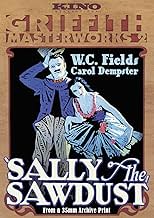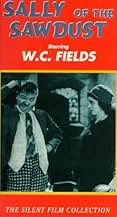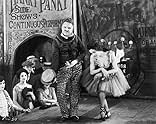Judge Foster throws his daughter out because she married a circus man. She leaves her baby girl with Prof. McGargle before she dies. Years later Sally is a dancer with whom Peyton, a son of ... Read allJudge Foster throws his daughter out because she married a circus man. She leaves her baby girl with Prof. McGargle before she dies. Years later Sally is a dancer with whom Peyton, a son of Judge Foster's friend, falls in love. When Sally is arrested McGargle proves her real pare... Read allJudge Foster throws his daughter out because she married a circus man. She leaves her baby girl with Prof. McGargle before she dies. Years later Sally is a dancer with whom Peyton, a son of Judge Foster's friend, falls in love. When Sally is arrested McGargle proves her real parentage.
- Awards
- 3 wins total
- Leon - the Acrobat
- (as Glen Anders)
- Stooge
- (uncredited)
- Bandit
- (uncredited)
- Bit Role
- (uncredited)
- Yokel in the Old Army Game
- (uncredited)
- Director
- Writers
- All cast & crew
- Production, box office & more at IMDbPro
Featured reviews
Before Sally is born her well bred and off mother decides to run off with a show person against parents wishes and is disowned. With the father dead and the mother dying Poppy (Fields) agrees to return the child to her parents but then he decides to raise her himself. Together they tour and perform into her adulthood when the day of reckoning approaches, further complicated by Sally's romance with a swell and member of her grandparents polite society who disdain show people.
Directed by D.W. Griffith in the latter half of his career, Sally has a dated look for a 25 silent with many scenes hearkening back to his halcyon period a decade earlier as his famous montage style looks more like a Mack Sennett Keystone short in spots. Once again he focuses on societal hypocrisy and intolerance but it comes across hackneyed. Silent film had moved into its golden era and Griffith remained inert while Vidor, DeMille and Ingram were taking form and content to another level.
Fields is both funny and touching as he protects Sally and tries to make a living in a variety of dubious enterprises. Dempster is remarkably agile as she takes her licks in more than one scene as well as have a chameleon like look that goes from homely tomboy to deco sleek vamp. It is the energy and talent of both that carry Sally as they leave D.W. anachronistic style in the dust.
However, he was not the "star" of this movie. That title would go to Carol Dempster. Dempster is something of a polarizing figure for silent film fans. Many have labeled her as a talentless and unattractive Lillian Gish wannabe whose supposedly awful performances led to DW Griffith's creative and commercial downfall. It's true that Dempster could be inconsistent as a performer, but when she was good, she was superb. Dempster really appears to enjoy this role, and it shows. She is by turns irreverent, spunky, feisty, happy, and touchingly sad; you can see the ache in Sally's heart as she yearns for the love of family. Dempster is highly expressive and uses her trademark athleticism and dancing skills to great effect. She radiates a kooky charm throughout and many of her facial expressions are amusing. I personally thought she carried the role very well, and I have watched this movie multiple times in order to relive moments from her performance.
As a movie overall, the film has its strengths and weaknesses. Griffith had obviously mastered the art of cinematography and there are some nice sequences at the circus, as well as the protracted chase scene near the end of the movie. The editing, as has been noted above, is comically bad. The most outstanding example is when the cops come to bust McGargle's shell game operation and take Sally away, it's clearly night time, but the cut to McGargle's escape is in broad daylight! Also, as has been noted, Griffith was NOT a comedy director. One can only imagine the zaniness that Buster Keaton or Hal Roach would have brought to the chase scene, but Griffith doesn't have the right feel for it. The movie is more amusing than laugh-out-loud funny. Whatever does work in the movie is more due to the cast (minus Alfred Lunt, whom I found very bland as the would-be boyfriend) than the script or direction.
In conclusion, SALLY OF THE SAWDUST, while not a "great" film, has two great performances (by Fields and Dempster) and is an agreeable way for silent movie fans to spend two hours.
I did enjoy this film. I thought Carol Dempster was good in her role, but of course I was more interested in the times when Fields is on screen. There are some specific moments for Fields fans to savour. The fleeting shots of his juggling skills, the first evidence of the subtle reactions and gestures that we know from his classic talkies of the 1930's, and the peanut cart disguise for a liquor cabinet that survives from his Zeigfield Follies days.
This won't be a movie I turn to as often as I do to the great W.C. Fields films of 1932-34, but I'm just so glad that it has not been lost to us as have been other of Fields silent film work.
The picture sees him teamed up with pioneer director D.W. Griffith, now sadly long past his glory days. Griffith was never really much of a comedy director. He doesn't seem to have the confidence in his performers to let them do their stuff and allow the scenes to play out. Instead he seems stuck in the Keystone Cops mode of slapstick, which is always very frenetic, with lots of cuts. In a way this works out well because Griffith could at least direct a good action sequence, and scenes like the punch-up at the circus even if not very funny are at least nicely timed and escalated. Besides, even if the comedy fails the general air of irreverence stops the picture from getting too mawkish.
It is also rather nice to see Griffith returning to a simple, human story, as his usual epics with ride-to-the-rescue finales had been getting a little stale of late. Sally of the Sawdust more than any other harks back to the short films he made in the early teens for the way he focuses on individuals rather than wider social processes. There are some good examples of the way he builds up an emotional story. In the prologue, when the daughter is kicked out, we see the mother and father turn away from each other to face opposite walls, the camera well back in the large space, a perfect evocation of this cold, fractured household. And Griffith is still so good at expressing a feeling with the most delicate of close-ups, showing us for example Carol Dempster's hand clutching at the grass as she canoodles with Alfred Lunt. Acting performances vary immensely across Griffith's body of work, but the relatively restrained turns from Dempster and Elfie Shannon as old Mrs Foster add immensely to the poignant final scenes.
But what of W.C. Fields himself? We here and there see him going off into some bit of comedy business, but the truth is as a slapstick comic he is nothing really exceptional. He doesn't have the energy or flexibility to keep up with the wilder slapstick, and sequences like the one where he keeps knocking off his own hat just look out of place. Of course there is a lot more for him to do in Sally of the Sawdust, and Fields is at his funniest when simply acting out bits of the play (presumably kept intact from the original stage version) in his own characteristic manner. When trying to evade the police, he emerges from his hiding place wrapped in a cloak disguised as an Indian, and it is the way he strolls towards the camera, nonchalantly puffing on a cigar, that makes the moment funny. Still, there is clearly something missing from the act – the delivery, the voice, not to mention the opportunity to develop a curmudgeonly character without having to occasionally play the clown. It is no wonder his screen career never really took off until the arrival of the talkies.
Later remade as Poppy (the original title) with Fields in the same role.
Did you know
- TriviaD.W. Griffith had good reason not to use the name or title "Poppy" for this movie -a movie titled "Poppy" with a character by that name had come out in 1917.
- GoofsWhen Sally and Eustache were lying on the railway, after get wet on the train, you can clearly see that the railway ends on the film studio wall, right behind them.
- ConnectionsFeatured in W.C. Fields: Straight Up (1986)
Details
Box office
- Gross US & Canada
- $304,081
- Runtime1 hour 44 minutes
- Sound mix
- Aspect ratio
- 1.33 : 1
Contribute to this page
































